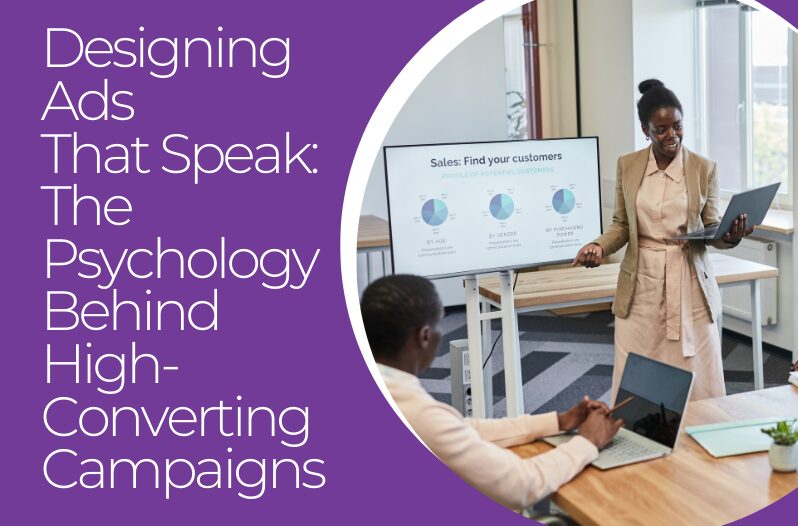Why do some advertisements instantly grab your attention while others fade into the background? It’s not just clever slogans or eye-catching visuals at play; the secret lies in understanding human psychology. The most successful ads don’t just communicate—they resonate, triggering emotions, thoughts, and actions that drive results.
From the colours that capture our gaze to the words that compel us to click, every element of a high-converting campaign is meticulously crafted to align with the way our brains process information. Whether it’s leveraging emotional triggers, using the science of trust, or perfecting a call to action, great ad design is as much about psychology as it is about creativity.
Understanding the Role of Psychology in Advertising
Psychology is the foundation of effective advertising. At its core, advertising aims to influence human behaviour, and understanding how people think, feel, and make decisions is crucial. Psychological principles such as emotional appeal, cognitive biases, and behavioural triggers play a pivotal role in shaping campaigns that connect with audiences.
Emotional Triggers
Emotions are powerful drivers of action. Ads that evoke strong emotions—whether joy, fear, nostalgia, or excitement—are more likely to be remembered and acted upon. For instance, fear-based messages such as “Limited Time Offer!” tap into the fear of missing out (FOMO), prompting immediate action. Similarly, nostalgic imagery or storytelling can create a sense of warmth and familiarity, fostering a deeper connection with the audience.
Cognitive Biases
Cognitive biases, the mental shortcuts our brains use to make decisions, are another key factor in advertising. For example, the “social proof” bias—the tendency to follow the actions of others—can be leveraged by showcasing testimonials, user reviews, or statistics like “Trusted by 1 Million Customers.” Ads that use these biases effectively can subtly nudge consumers toward a desired action.
Behavioural Triggers
Behavioural triggers like urgency and scarcity are also central to high-converting ads. The idea that something is in limited supply or available for a short time only creates a sense of urgency that drives immediate action. By understanding and applying these psychological insights, advertisers can design campaigns that resonate on a deeper level.
The Visual Elements of High-Converting Ads
While psychology provides the blueprint, visual design brings it to life. The interplay between colours, typography, imagery, and layout is crucial to capturing attention and conveying a message effectively.
The Psychology of Colour
Colour plays a significant role in shaping perceptions and emotions. For example, red is often associated with urgency and excitement, while blue conveys trust and stability. Choosing the right colour palette can reinforce your message and influence how your audience feels about your brand. However, it’s essential to balance boldness with consistency to avoid overwhelming viewers.
Typography and Readability
Typography can subtly influence how your message is received. Fonts that are clean and easy to read ensure that the message is clear, while more stylised fonts can add personality. Balancing readability with creativity is key; a font that’s too elaborate might detract from the message, while one that’s too plain might fail to capture attention.
Visual Hierarchy
A well-structured visual hierarchy ensures that viewers’ eyes are naturally drawn to the most important elements first, such as the headline or call to action. Larger fonts, contrasting colours, and strategic placement can all be used to guide attention effectively.
Crafting Persuasive Ad Copy
Even the most visually stunning ad can fall flat without compelling copy. Your words should resonate with your audience, address their challenges, and inspire action.
Headlines That Hook
Your headline is often the first thing people see, and it needs to make an immediate impact. Using curiosity, urgency, or a direct benefit in your headline can increase the likelihood of engagement. For instance, “Unlock the Secret to Saving 50% on Your Next Holiday” combines curiosity and a clear benefit.
Personalisation and Relevance
Ads that feel personal are more likely to convert. Addressing the audience directly (“You” and “Your”) or using dynamic personalisation tools to insert names or locations can make the ad feel tailored to the individual.
Strong Calls to Action (CTAs)
A compelling call to action is essential. Phrases like “Get Started Today,” “Claim Your Free Trial,” or “Shop Now” create a sense of immediacy and direction. Testing different CTAs can help identify what resonates most with your audience.
Balancing the various elements of ad design is not without challenges. Overloading an ad with too many elements can dilute its message, while focusing too heavily on one aspect (e.g., visuals) might neglect another (e.g., copy). Additionally, what works for one audience or platform may not work for another. Testing and refining your approach is crucial to achieving the right balance.
Another key challenge is maintaining authenticity. While psychological triggers can drive action, overusing tactics like urgency or scarcity can come across as manipulative if not applied judiciously. It’s vital to maintain trust by delivering on promises and aligning your messaging with your brand values.
Conclusion
Designing ads that truly speak to your audience requires a blend of psychology, creativity, and strategy. By understanding how people think and feel, crafting compelling visuals and copy, and carefully balancing the elements of design, you can create campaigns that not only capture attention but also drive meaningful action.
Remember, the most successful ads are those that resonate on a human level. By applying the principles discussed in this post, you’ll be well on your way to designing campaigns that inspire, engage, and convert.





